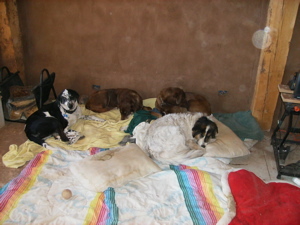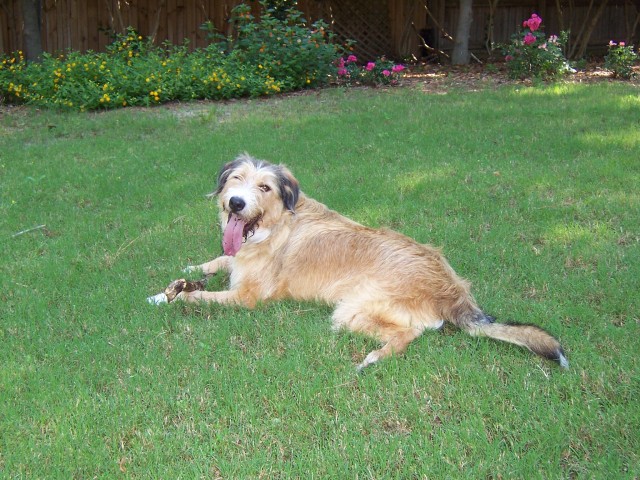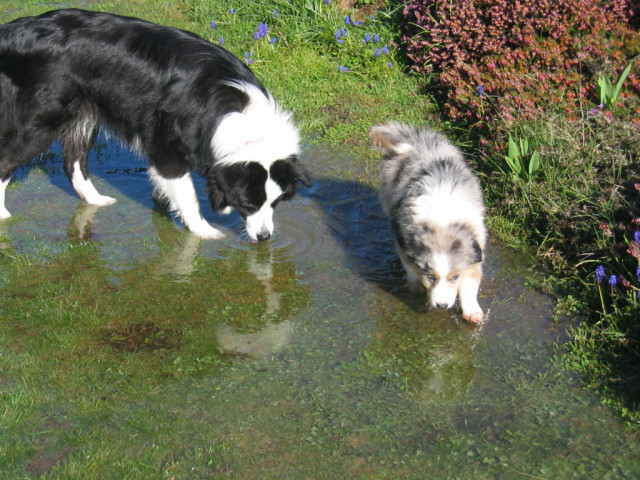QuestionDr Connor,
My husband and I have recently (DEC 23,08)adopted a female Dachshund/rat terrier mix (Roxie)from our local no kill shelter and are having small issues with her. Also in the home is our 5 yr old male JRT (Nitro) and two senior cats. We adopted her as a companion for Nitro and they are getting along great including the cats, or so we think. When they are together they romp and play tug o war inside and outside. However about a week after she came into our home the behaviors started. When we try to address her or move toward her to pet her she urinates and rolls over. She also has an issue with going outside when we ask. She doesnt want to move from her spot, whether its her crate with open door or from one of the doggie beds in the living room. We have not raised voices to her and use the same tone an manner because we know she cannot help the urinating and don't know what she has been through in her short one year of life. We let her approach us. She is learning to crate when asked (and receives reward after). We believe her to be housebroken, the two defecating accidents that have happened we are assuming were because of a change in her routine. Any help would be greatly appreciated or if you can direct us to others that might be of assistance. If you need further information please just let me know.
AnswerThe first few weeks of living with a "rescue" dog is the honeymoon period; you have yet to see if there is any behavioral problem with this dog that landed her in that precarious situation (kill shelter). It's often simply a miscreant human, but sometimes issues begin to appear after the first two to three weeks. your two dogs are working out their relationship via play, and that's normal and fine. If she had serious issues with cats (and surprising she doesn't, that tells me she may have lived with cats), you would already have seen it. The behaviors that concern you are very probably the result of abusive treatment or serious mismanagement in her former home. Someone must have made a BIG DEAL about taking her out, or putting her out, and most likely because of house training issues. Defecation is the last elimination behavior to fall into line when house training a dog (even when you know what you're doing). She may experience direct approach as very threatening BECAUSE someone directly approached her to discipline her for inappropriate elimination (including submissive urination which is interpreted by the clueless as a house training issue). Her fear of being led outdoors (or dragged out of her crate, trust me, there are people who do this and worse) is most likely directly the result of such events, also.
Learn about positive reinforcement training: go to ClickerTraining.com (but be careful of the clicker, introduce it from your pocket, she may be afraid of the sound.) Teach her ONE behavior, slowly over the course of many days: choose "sit", as this is a natural posture and easily obtained by slowly stepping toward the dog. Use another word (I'm almost certain the actual word has been abused.) Once she has gotten the IDEA that "sitting" to your command earns reward (and treat), she will happily do so on command under normal circumstances. This will help her to trust you, enhance her security and cognitive skills, and give her a way to please you. Once she's obtained this behavior, use your clicker (or whatever marker you have chosen) to reward (and then treat) any voluntary movement out of her crate (while you are present.) Create a cue for it: "good OUT") and she will soon associate that word "OUT" with leaving her crate, the click or other marker, and food treat. Once she has begun to voluntarily leave her crate on the word "OUT", do not reward other leavetakings from the crate (or the dog may make a career out of going in and out of the crate.) You will then have a command to get her out of her crate AND she will have lost her fear of doing so.
Until then, if you must have her out of the crate for any reason, CLOSE THE DOOR. Do not allow her to make the choice to hide in there; only allow her in when you are ready (after she's been in for a few minutes) to introduce the "OUT" command. Let her use the crate at night, or when you are going to be absent from the home, and at these times do NOT attempt to cajole or force her out of the crate. Leaving a tiny trail of something good that she can CHOOSE to follow (while you are ostensibly elsewhere doing something else and then can go close the crate door) should suffice. She will, out of your sight, follow a trail of tiny treats. IGNORE HER when she does this, don't make a big deal out ofit, just go calmly close the crate door.
Establish a steady, consistent and fair routine of taking her outdoors to eliminate and reward/praise every elimination. A young adult dog new in a home may need to go out more than six or seven times a day, and that can then be fairly reduced to first thing AM, midday, midafternoon, late afternoon, and just before bed. If she has accidents (and she most likely will) IGNORE THEM. Don't clean them up in front of her. Don't point them out to one another or use her name in association with them. This dog has been psychologically harmed by neanderthal house training methods. She WILL come around so long as you reward/praise what you WANT and IGNORE what you don't want.
Regarding her submissive urination and abject submission (rolling over), approach her from a CURVE, NOT straight on; do NOT make direct eye contact; do NOT use her name; lick your lips and yawn (stress reducing signals). Do NOT bend over her. If she rolls over, WALK AWAY. This is an abject sign of submission and any higher ranking member of any "pack" DOES walk away at the rollover (unless there's an active altercation immediately preceding it.) You will be giving her a signal in her own language that you understand. Walking on a curve toward a dog is the non-threat approach; lip licking and yawning are saying, "it's ok". Respect the dog's body language. Promote her emotionally with positive reinforcement training. Reward and praise for every attempt she makes to please you. Read turid Rugaas' "Calming Signals", this will help enormously as you will then be able to read her body language and react accordingly. Please repost with any further questions.

 Companion for Lonley Westie
Question
Shannon
We have a 5-year-old neutered Westie w
Companion for Lonley Westie
Question
Shannon
We have a 5-year-old neutered Westie w
 Sudden aggression within pack after a death
Question
Sudden aggression in o
We have an approximatel
Sudden aggression within pack after a death
Question
Sudden aggression in o
We have an approximatel
 anxious dog
Question
Louie
Hi, We adopted a 2 year old male A
anxious dog
Question
Louie
Hi, We adopted a 2 year old male A
 Dog in Heat?
QuestionLily and Jorge
QUESTION: Hello,
We have
Dog in Heat?
QuestionLily and Jorge
QUESTION: Hello,
We have
 Agressive 1 yr old mini goldendoodle
Question
our millie
My husband and I got our min
Agressive 1 yr old mini goldendoodle
Question
our millie
My husband and I got our min